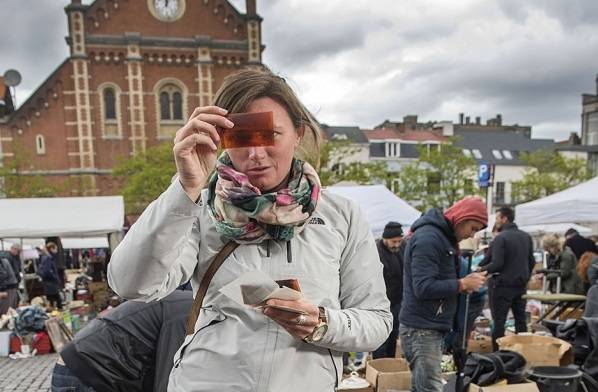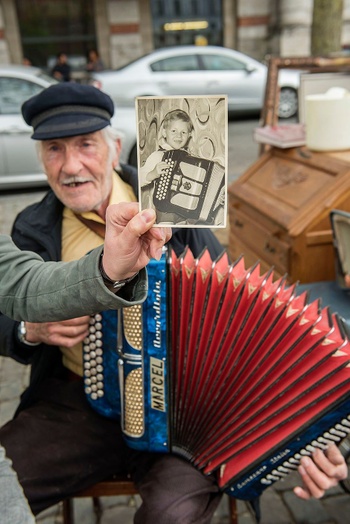Two boxes of old glass negatives, bought for €20 at the Brussels flea market. That’s all it took to get Collectief S working on a recycling project. Their “N°50 Rue Pasteur” exhibition focuses on the story behind abandoned photographs.

Collectief S uses lost pictures to recreate stories from the past
It was just under five years ago that Leon Saenen, Inge Schols, and Rebecca Smeets, who make up Collectief S, started their renewed pictures project. Back then, they were taking a photography course at the academy in Hasselt and decided to head off to the flea market in the Marollen/Marolles district of Brussels. Little did the trio of amateur photographers realise that that would be the first step on a long and bumpy road – one that has now led to an exhibition at Recyclart.
“We were given the task of doing something with old photographs,” recalls Leon Saenen, the senior member of the trio, which for the occasion has got together once again where it all began. It immediately becomes clear that there are at least as many old photographs on sale as ever. The vintage craze has hit the flea market too – as one can see from the prices dealers are asking for old plates. But there are also more crates and boxes of photographs, sometimes mixed in with postcards and other correspondence.
“Like kids in a lucky dip,” laughs Saenen, a retired train-driver, as the ladies dive into a box. “Yeah, but all the pictures with trains are for him!” they respond. As we ourselves hold a negative up to the light and see an old-model tram 81 passing through a Brussels street, our thoughts automatically turn to the people who travelled in it back then. “You see, that’s how it starts,” says Smeets. “You’re triggered by something you recognise and then by the mystery behind it. When you can connect a story to it, a picture takes on more significance. Otherwise, it’s just a photograph.”
Business card
The nonchalant and random way in which old pictures are dealt in here is in stark contrast with the personal view we are offered inside bygone human lives. “Photographs often show trivial things, but every now and then they are immediately moving,” says Schols. “That’s why it’s such a pity that they regularly end up on the ground here.”
Saenen, too, thinks it’s a shame; he adds that, here, pictures have lost their emotional significance. “Collectief S aims to recycle these neglected, emotionally charged pictures and give them a new raison d’être. In the portraits we came across here in 2012, for example, it was clear straight away that a family had come together for a major event. That stimulated our curiosity.”

© Ivan Put
“To protect the old glass negatives, there were postcards and also two business cards in between them, one from Georges Van den Dooren in Paris and one from Raphaël Van den Dooren in Lille,” recalls Saenen. These would prove crucial to the reconstruction of the family’s story.
“In the first place, they led us to an address in Paris,” says Schols. “All the current residents got a letter in the post. But that got us nowhere. During our visit, we did manage to get two residents to pose for a photograph, but there was no trace of the Van den Doorens.” As the old glass negatives also included some views of the sights of Tournai, Lambersart, and Lille, the search shifted to northern France. “Dozens of mails and letters, however, sent to a variety of Van den Doorens in the region, turned up nothing, which made us suspect that maybe there were no descendants,” says Smeets. “Maybe they fled to England. World wars, after all, seriously disrupt the transmission of family traditions.”
Immortal
Information about a census, found on the Internet, would eventually, however, reveal the complete line-up of the Van den Dooren family. It turned out that they came from Tournai, where the birth certificates were found that you can see in the exhibition. What’s more, by typing the name Van den Dooren into the Delcampe website, a sort of eBay for collectors, Saenen succeeded in getting his hands on some letters from Georges Van den Dooren.
“It turned out that at the beginning of the twentieth century he used to travel around northern France as a commercial traveller for Unilever, selling Sunlight soap. On the road, he used to write letters to his wife in Paris and those letters, like our glass negatives, probably fetched up in a wee market somewhere and were bought with a view to selling them on.”
The trio’s persistence was finally rewarded when they travelled to La Madeleine, near Lille, with one of Raphaël Van den Dooren’s business cards. “From the opposite side of the street, we were able to look into the house at No. 50 rue Pasteur and we saw the very same stained-glass window that was in our glass negatives,” they were delighted to find.
Over a hundred years after the original photo session, the present resident was happy to have herself portrayed in front of the door where it all began – but digitally, this time. “We never understood more clearly what to ‘immortalise’ means,” declared the trio, which has now started work on a new recycling project, this time with old zinc printing plates, also found at the Brussels flea market.
Browsing amid the plates, Smeets is compelled to observe that times have changed. “We were looking at the album of a journey just now in which all the photographs were neatly stuck in. Who does that any more, in the digital age? Maybe in the future we should go looking for discarded hard disks?”
Because of the interest we have shown and the presence of a photographer, the price of the box of photographs and negatives in front of us has suddenly risen to €120. Too high to even begin haggling. “We’d be better off spending that money on another trip to Paris,” is the unanimous reaction.
> N° 50 Rue Pasteur. 19/05 > 01/06, Vitrin 21, Recyclart, Brussels
Read more about: Expo
Fijn dat je wil reageren. Wie reageert, gaat akkoord met onze huisregels. Hoe reageren via Disqus? Een woordje uitleg.